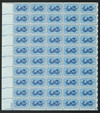
1955 3¢ Atoms for Peace
# 1070 - 1955 3¢ Atoms for Peace
$0.35 - $27.50
U.S. #1070
1955 3¢ Atoms for Peace
1955 3¢ Atoms for Peace
Issue Date: July 28, 1955
City: Washington, D.C.
Quantity: 133,638,850
Printed by: Bureau of Engraving and Printing
Printing Method: Rotary Press
Perforations: 11 x 10 ½
Color: Deep blue
City: Washington, D.C.
Quantity: 133,638,850
Printed by: Bureau of Engraving and Printing
Printing Method: Rotary Press
Perforations: 11 x 10 ½
Color: Deep blue
U.S. #1070 was issued in honor of President Dwight D. Eisenhowers address to the United Nations in December 1953. Called Atoms for Peace, the speech laid out Eisenhowers vision of the use of nuclear power for peace, rather than destruction. The world had witnessed the destruction of Hiroshima and Nagasaki, Japan, by atomic bomb, less than a decade earlier. Eisenhowers speech helped ease fears of atomic war, even in the early years of the Cold War.
U.S. #1070
1955 3¢ Atoms for Peace
1955 3¢ Atoms for Peace
Issue Date: July 28, 1955
City: Washington, D.C.
Quantity: 133,638,850
Printed by: Bureau of Engraving and Printing
Printing Method: Rotary Press
Perforations: 11 x 10 ½
Color: Deep blue
City: Washington, D.C.
Quantity: 133,638,850
Printed by: Bureau of Engraving and Printing
Printing Method: Rotary Press
Perforations: 11 x 10 ½
Color: Deep blue
U.S. #1070 was issued in honor of President Dwight D. Eisenhowers address to the United Nations in December 1953. Called Atoms for Peace, the speech laid out Eisenhowers vision of the use of nuclear power for peace, rather than destruction. The world had witnessed the destruction of Hiroshima and Nagasaki, Japan, by atomic bomb, less than a decade earlier. Eisenhowers speech helped ease fears of atomic war, even in the early years of the Cold War.








